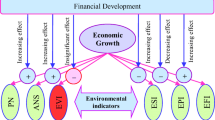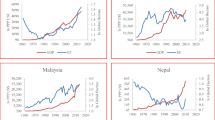Abstract
An increase in economic activities which leads to economic growth has been adduced as a possible factor for environmental degradation. While some other studies have argued that as economies keep growing, there are possibilities for resource redistribution which could engender environmental balance, thus engendering the argument on the conflicting-complementary position of the environment-growth nexus. In the light of this, this study uses previous activities between economic activities and the environment to determine the conflicting or complementary relationship that exists between economic growth and the environment. Also, using Nigeria as a case study, the design of environmental growth nexus to achieving sustainable development is assessed. Annual time series data between 1970 and 2014 were sourced from the World Development Indicators. Following the neoclassical perspective on ecological growth and the Kuznets inverted U-hypothesis on the environment-growth relations, stationarity test was performed, and the autoregressive distributed lag estimates were employed. From the study, it is seen that factors like rainfall that promotes environmental quality in the long run promote economic growth (per capita and GDP growth) in Nigeria. Similarly, factors like natural resource utilization, which depletes environmental quality, increases economic growth but reduces economic growth per capita; thus, with questions for development, the possibility of a complementary relationship for environmental quality and economic growth is spotted if the right policies are ensured. Also, the study found evidence of a growing conflicting relation between environmental quality (CO2) and economic growth (per capita and GDP growth). Meanwhile, these conflicts to a great extent find expression in the Kuznets hypothesis; such that, if policies that promote income per capita reduces pollution and pursues eco-efficiency via economic growth are properly harnessed, there are the prospects of meeting up with the goals of environmental sustainability in developing economies.

Similar content being viewed by others
Notes
In\( \left(\frac{Y_t^{\ast }}{L_t}\right)=\ln {A}_0+ gt-\frac{\alpha }{1-\alpha}\ln \left({\hat{n}}_t+\delta \right)+\frac{\alpha }{1-\alpha}\ln \left({s}_k\right)+{\theta}_1\ln \left({Q}_t\right)+{\theta}_2\ln \left({E}_t\right) \)
Specifically, \( \left(\frac{Y_t^{\ast }}{L_t}\right) \)is expressed as GDPCt. In the model, environmental quality represented by Qt is explained as a determinant of per capita income among other variables such as productivity (E0) and human capital (Et).
Kuznet hypothesis states that “as an economy’s per capita income increases, the total amount of environmental impact of economic activities initially grows, reaches maximum and then falls
This approach is found to be applicable irrespective of the order of integration of variables, evades the need for pre-testing the integration order of variables, allows the variables to have different optimal lag length of deriving a dynamic unrestricted error correction model from the approach via a simple linear transformation and it integrates both the short run dynamics and long run dynamics together without loss of any long run information (see Pesaran et al. 1999 and 2001; Narayan and Smyth, 2005; Akinlo, 2008 and among others)
`
The same ARDL estimation technique is applied for robustness checks.
The variable NRES was removed from the presentation after several iterations revealed explosive and insignificant estimates.
References
Adejumo OO (2018) Issues in sustainable development: the environment–income relationship. In: Financing sustainable development in Africa. Palgrave Macmillan, Cham, pp 317–338
Ahmed A, Herve DB, Zhao L (2012) Empirical study on relationship between environmental pollution and economic growth of Maldives using environmental Kuznets curve and OLS method. Int J Bus Manage 7(21):15
Akinlo AE (2008). Energy consumption and economic growth: Evidence from 11 Sub-Sahara African countries. Energy economics, 30(5):2391–2400
Alege PO, Ogundipe AA (2015) Environmental quality and economic growth in Nigeria: a fractional cointegration analysis. Int J Dev Sustain 2(2)
Andrei J, Mieila M, Popescu G, Nica E, Cristina M (2016) The impact and determinants of environmental taxation on economic growth communities in Romania. Energies 9(11):902
Andreoni, J., & Levinson, A. (2001). The simple analytics of the environmental Kuznets curve. Journal of public economics, 80(2), 269–286
Awan GA (2013) Relationship between environment and sustainable economic development: a theoretical approach to environmental problems. Int J Asian Soc Sci 3(3):741–761
Balibey M (2015) Relationships among CO2 emissions, economic growth and foreign direct investment and the environmental Kuznets hypothesis in Turkey. Int J Energy Econ Policy 5(4):1042–1049
Bassanini A, Scarpetta S (2001) Does human capital matter for growth in OECD countries? Evidence from pooled mean-group estimates. OECD Department Working Paper No. 282
Beckerman, W. (1992) “Economic growth and the environment: Whose growth? Whose Environment?” World Development, 20, 481–496
Central Bank of Nigeria (2005) Major financial indicators. Central Bank of Nigeria P.M.B. 0187, Garki, Abuja
Chindo S, Abdulrahim A, Waziri SI, Huong WM, Ahmad AA (2015) Energy consumption, CO 2 emissions and GDP in Nigeria. GeoJournal 80(3):315–322
Chuku, A. (2011). Economic development and environmental quality in Nigeria: is there an environmental Kuznets curve?
Dasgupta S, Laplante B, Wang H, and Wheeler D (2002) “Confronting the Environmental Kuznets Curve.” Journal of Economic Perspectives, 16(1):147–168
Drabo A (2011) Interrelationships between health, environment quality and economic activity: what consequences for economic convergence. Hal Archives Ouvertes, halsh-00552995
Goodstein S. E. and Polasky, Stephen (2014). Economics and the environment. Wiley, United States of America, ISBN978–1–118-53972-9
Grossman G, Krueger A (1993) Environmental impacts of a North American free trade agreement. In: Gamber P (ed) The US-Mexico Free Trade Agreement. MIT Press, Cambridge
Grossman GM, Krueger AB (1995) Economic growth and the environment. Quarterly J Econ 110(2):353–377 The MIT Press Stable
Grossman, GM, & Krueger, AB (1994). Economic growth and the environment (No. w4634) National Bureau of Economic Research, 10,w4634.
Hussen MA (2000) Principles of environmental economics, Routledge, London and Newyork
Kuznets, S. (1955). Economic growth and income inequality. The American Economic Review, vol. 45, no. 1
Magnani E, Tubb A (2007) The link between economic growth and environmental quality: does population ageing matter? Int J Glob Environ Issues
Martinez-Alier J (1995) Distributional issues in ecological economics. Rev Soc Econ 3(5):11–28
Mensah, A. C. E. (2017). Trade-induced environmental effects: the role of factor endowment and environmental regulation (Doctoral dissertation, University Of Ghana)
Narayan PK, & Smyth R (2005). The residential demand for electricity in Australia: an application of the bounds testing approach to cointegration. Energy policy, 33(4):467–474
National Bureau of Statistics (NBS): Social Statistics in Nigeria. (2015) Abuja, Nigeria: National Bureau of Statistics, [http://www.nigerianstat.gov.ng/]
National Environmental Standards and Regulations Enforcement Agency (NESREA) (2011) https://www.nesrea.gov.ng/publicationsdownloads/laws-regulations/
Nnaji CE, Chukwu JO, Nnaji M (2013) Electricity supply, fossil fuel consumption, Co2 emissions and economic growth: implications and policy options for sustainable development in Nigeria. Int J Energy Econ Policy 3(3):262–271
Nnanna OJ, Alade SO, Odoko FO (2003) Contemporary economic policy issues in Nigeria. Central Bank of Nigeria ISBN: 978-37024-0-8
Ozturk I, Acaravci A (2013) The long-run and causal analysis of energy, growth, openness and financial development on carbon emissions in Turkey. Energy Econ 36:262–267
Panayotou, T. (1993). Empirical tests and policy analysis of environmental degradation at different stages of economic development. Working paper WP238, Technology and Employment Programme, International Labour Office, Geneva
Panayotou T (2016) Economic growth and the environment. Environ Anthropol:140–148
Panayotu T (2003) Economic growth and the environment. Economic Survey of Europe, 2003 No.2
Pesaran MH, Shin Y, & Smith RP (1999). Pooled mean group estimation of dynamic heterogeneous panels. Journal of the American Statistical Association, 94(446):621–634 Association, 94(446), 621-634
Pesaran MH, Shin Y, & Smith RJ (2001). Bounds testing approaches to the analysis of level relationships. Journal of applied econometrics, 16(3):289-326
Pinkovskiy ML (2017) Growth discontinuities at borders. J Econ Growth 22(2):145–192
Saidi K, Hammami S (2015) The impact of CO2 emissions and economic growth on energy consumption in 58 countries. Energy Rep 1:62–70
Shafik N, Bandyopadhyay (1992) Economic growth and environmental quality: time series and cross-country evidence. The World Bank, Background Paper for the World Development Report 1992
Srivastava N. Yogendra (2009). Environmental Pollution. S.B. Nangia, A. P. H Publishing Corporation, 4435-36/7, Ansari Road, Darya Ganj, New Delhi-110 002. ISBN 978-81-313-0477-8
Stern, D (2004), “The Rise and Fall of the Environmental Kuznets Curve.” World Development, vol. 32, no. 8, pp. 1419–39
Torras M, Boyce JK (1998) Income inequality and pollution: a reassessment of the environmental Kuznet curve. Ecol Econ 25:147–160
Author information
Authors and Affiliations
Corresponding author
Additional information
Responsible editor: Philippe Garrigues
Publisher’s note
Springer Nature remains neutral with regard to jurisdictional claims in published maps and institutional affiliations.
Appendices
Appendix 1
Appendix 2
Appendix 3
Appendix 4
Rights and permissions
About this article
Cite this article
Adejumo, O.O. Environmental quality vs economic growth in a developing economy: complements or conflicts. Environ Sci Pollut Res 27, 6163–6179 (2020). https://doi.org/10.1007/s11356-019-07101-x
Received:
Accepted:
Published:
Issue Date:
DOI: https://doi.org/10.1007/s11356-019-07101-x








